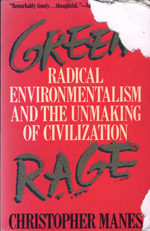» Next Entries
The Archives
-
No Compromise, Periodicals
No Compromise #23-26
02.17.13 | PermalinkNo Compromise 23-26 (2004, Santa Cruz / San Francisco, CA)
One of the lessons that archiving old animal liberation publications has taught me is that the most extreme actions have rarely produced much in the way of results for animals. A public that already sees veganism as odd might still see the value of rescuing animals from a laboratory, but will never support a car bombing. When innocents are injured, or when murder was the goal, the backlash starts to creep into our own ranks, and as we fracture law enforcement and industry groups take advantage. In the end, I can think of no bombing (or contamination, or grave robbing, etc.) which advanced the cause of animal rights more than it harmed it. This is not to say that bombings and the like could never be successful. At later stages of many revolutionary struggles, when the majority of the public supports the cause, bombs can clear away in one night what years of protest could not. While a movement is in its infancy, however, it could be argued that more often than not bombs blow up in our faces.
And so it was in 2004 when a group calling itself the Revolutionary Cells Animal Liberation Brigade carried out two bombings of HLS related targets in California. The movement was left to make lemonade from truly shitty lemons, and No Compromise did their best to mitigate the harm of the actions while keeping activists focused on the real enemy.
The year continued with the indictment of the SHAC 7, the emergence of Austria as a leader in the movement, and some exciting open rescues. Sarahjane Blum and Ryan Shapiro’s organization, GourmetCruelty.com, carried out one such operation that piqued public interest and eventually resulted in a sympathetic program on Animal Planet. Elsewhere Gina Lynn was imprisoned for defying the Seattle grand jury, Billy Cottrell was arrested for a massive SUV dealership arson, and the Universtiy of Iowa was treated to the most sophisticated lab raid to occur since the early 90s.
Every time we post a year of No Compromise we say the same thing: that this is essential reading for those who wish to understand the recent history of our movement. This posting is no exception. No Compromise was the best AR publication of its era, and 2004 saw the publication refining its strengths and providing their readers with four of the best issues yet.
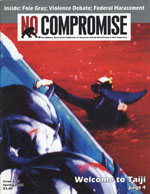



-
Books, Most Popular
Green Rage
12.03.12 | PermalinkGreen Rage: Radical environmentalism and the unmaking of civilization (1990, Boston, MA.)
One of the first books I bought about radical wilderness defense was Green Rage. It is an excellent investigation of the origins of (western) environmental radicalism, and I recommend that you read it cover to cover.
Speaking of covers, you might notice that this particular copy of Green Rage is a little ragged. The reason for that is because this is my copy, and after reading the book I took it’s message to heart. Several years ago in Oregon, a small group of activists from around the region were protesting at a breeding facility that supplied rabbits to the vivisection industry. When we arrived the farms owners were not present, and neither were any law enforcement. Not coincidentally I quickly found myself living with some critters who liked to chew on everything in our humble home. I hope you will enjoy Green Rage as much as they did!
…
-
No Compromise, Periodicals
No Compromise #12-14
05.15.12 | PermalinkNo Compromise #12-14 (1999, Old Bridge, NJ and Santa Cruz, CA)
If I had to create a list of my favorite years in animal and earth liberation history, 1999 would be in the top 5. As the movement looked towards the new millennium there seemed to be an intense urgency in the air, perhaps people felt the need to close the 20th century with a bang or leave their mark before the world ended in a technological melt down on Y2K! Whatever the reasons, direct action reached a fever pitch. Lab raids returned to the United States, the Earth Liberation Front continued it’s ascendancy, Hillgrove farm was shut forever, and everyone seemed to be preparing for the World Trade Organization ministerial in Seattle. Across the globe there was a sense that people were not going to take it anymore, and whether you were struggling against bio-technology or prisons or speciesism, chances are good that you were employing some form of illegal tactic.
No Compromise may not have covered everything going on in the global struggle, but if it was animal lib related then chances are it was covered in these three issues. From the death of Alex Slack to end of the annual Hegins pigeon massacre, you’d be hard pressed to find a more complete overview of these twelve action packed months.
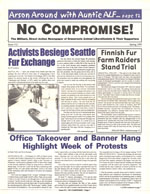
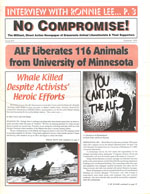
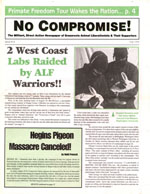
-
One-off publications, Videos
Angels of Mercy?
03.22.12 | PermalinkAngels of Mercy? (1995, London, England)
In 1995 Channel 4’s Warcries news program aired Angels Of Mercy?, a 30 minute investigation into the Animal Liberation Front. The show focused primarily on Keith Mann, an ALF volunteer who was then serving England’s longest sentence for animal rights motivated arson. While most commercially funded news has a clear bias in favor of the status quo (and the channels sponsors,) Warcries was known for fairer journalism. The result in this case was a surprisingly sympathetic look at what pushes a young person to commit criminal acts on behalf of non-humans. Given developments since it first aired, it also serves as a remarkable lesson about public credibility and how difficult it is to regain once lost.
In the 1990s our movement had a variety of articulate, savvy spokespeople, and the release of Angels of Mercy? quickly made Keith Mann foremost among them. His voice-overs from a prison phone are heard over shocking footage of animal abuse, and interviews with his family and supporters act to assure the audience that he is a rational and passionate activist working to stop what can only be described as horrific cruelty. When Keith was later released from prison he was highly sought after as a speaker and a source for reporters. I always felt reassured when I saw his face in the news since I knew it meant that at least one positive quote would make it’s way to the public.
Sadly, in the last few years Keith has become a devotee of British new-age guru David Icke, a man who believes that a race of reptilian shape-shifters secretly controls the world, that cancer is a fungus, that some humans are actually half-dead, inter-dimensional beings, and a host of other pseudo-scientific nonsense. After being literally laughed off of television in 1991 when he wrongly predicted the end of the world, he has resurfaced in recent years as a lecturer and author with a depressing number of followers.
Since his conversion to odd-ball conspiracy theorist Keith Mann has lost much of his credibility both inside and outside the movement. Most recently he has become a holocaust denier, thereby severing his ties with many of us who still held some hope that he would come to his senses. It’s a shame, because as I watch Angels of Mercy? I am reminded of the rare power he once had to make everyday people understand direct action and animal liberation, a power whose benefit is now lost to the animal nations. It is my hope that by posting this video others will consider how desperately the animals need trustworthy advocates, and how easy it is to damage that trust.
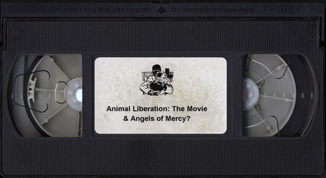
-
Periodicals
Things We Are Not Allowed To Show You, Part 1
01.08.12 | PermalinkThings We Are Not Allowed To Show You, Part 1 (Various Dates And Locations)
Since it’s very inception the United States has fought hard to take away, or manage into pointlessness, the rights “guaranteed” in the constitution and bill of rights. For proof one needs look no further than the first amendment: “Congress shall make no law respecting an establishment of religion, or prohibiting the free exercise thereof; or abridging the freedom of speech, or of the press; or the right of the people peaceably to assemble, and to petition the Government for a redress of grievances.” A thinking person could instantly rattle off any number of laws (and extra-legal government activity) that make nonsense of these words, particularly as they apply to free speech, the press, and the right of people to peaceably assemble!
Take for example 18 U.S.C. 842(p), the federal law concerning the distribution of texts involving explosives. Advocacy of armed action and violent revolution, even when intended to incite (but not likely to do so) is allegedly protected by the first amendment, but this law makes certain texts and websites illegal if the material therein is provided with knowledge or intent that the information will be used to commit a federal crime. Sounds reasonable right? Well, first one must consider the idea of intent, how it is proven, and how a person’s politics might be used to prejudice a jury against them. Second, one must consider that the Patriot Act provides considerable sentencing modifiers to any activity the government deems to be terrorism- even speech. The threat of twenty or more years behind bars could sway someone to self-censor (or plea to a lesser charge, even when they are innocent) when their “intent” could easily be misrepresented by a prosecutor.
Conflict Gypsy exists to archive rare and relevant publications of interest to militant animal and earth liberationists. Controversy is integral to the texts and images that we preserve and discuss, and in an ideal world we would be able to share all of the materials available to us. But, as it stands, we do have to worry about the dozens and dozens of state and federal laws that restrict free expression and sharing of ideas. Here is a small sampling of some of the covers of various publications that have at one time or another been distributed in radical non-human protection movements. We wish that we could share them in full and apologize to our readers that we do not live in a country where such liberty is afforded us.

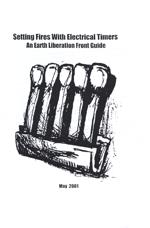
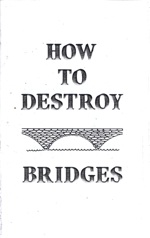
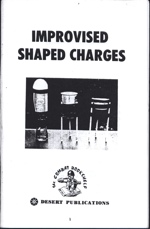
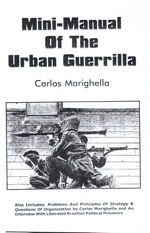
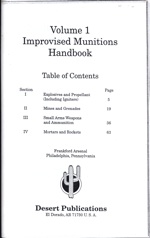
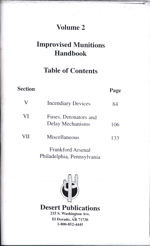
-
Arkangel, Periodicals
Arkangel #4,5,7
01.02.12 | PermalinkArkangel #4,5,7 (1990-1991. London, England)
Our posting of the complete Arkangel continues into the 90s with issues 4, 5, and 7. The omission of issue 6 is not an oversight- it was never printed. Arkangel was founded by Ronnie Lee, who was serving a 10 year sentence during the magazines early years, and edited by Vivien Smith, who found herself in a jail cell by the time issue #6 was scheduled for release. Sensing the possibility of shutting down this crucial publication, law enforcement in England ransacked the Arkangel office just before the layout of issue #6. It was lost to the ages, and with Vivien facing serious charges a new team of interim editors anonymously produced Arkangel #7, causing a slight decline in the publication’s overall quality.
The history covered by these three issues is tremendous. The death of Mike Hill, Animal Aid’s disastrous labeling of direct action as “terrorism,” and the return of the ALF Press Office are all reported upon, along with updates from groups around the world. Amidst the columns reporting on the actual work of activists though is a disturbing amount of debate, much of it centered on whether animal rights groups should allow participation by racists, nationalists, and separatists. The back and forth articles from one issue to the next mostly fail to recognize the most offensive nature of the argument – that there should even be an argument! It boggles the mind that anyone could see a benefit to taking on the baggage of these far right lunatics and their disgusting politics. During a decade where skinhead violence claimed the lives and dignity of so many it is particularly disheartening that some in our movement saw fit to offer these thugs a place at our table.

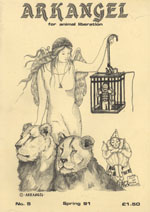

-
No Compromise, Periodicals
No Compromise #9, 10, 11
11.15.11 | PermalinkNo Compromise #9, 10, 11 (1998, Caldwell, NJ.)
After the shakeup caused by Freeman Wicklund’s departure, one might have expected No Compromise to slow it’s publishing schedule while it re-grouped. Instead, they had one of their most productive years, reporting on everything from the first daylight raid in the US, to the murder of Earth First! activist David “Gypsy” Chain. The volume of important articles in these issues is too great to summarize in a tiny blog post, so instead we would just like to encourage you to read each edition thoroughly. Truly, this is one of our favorite posts on Conflict Gypsy so far as it highlights so many significant events in the movement at the end of the 1990s.
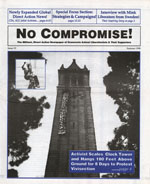
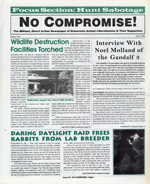

…
-
One-off publications
Nonviolence and Its Violent Consequences
11.08.11 | PermalinkNonviolence and Its Violent Consequences (2000, Gualala, CA.)
There are some debates that will rage forever without a conclusion: dogs vs. cats, West Coast vs. East Coast, tastes great vs. less filling… At the end of the day the answer to these questions means very little to the way that we live our lives and forge new, more just societies. There are, of course, angry divisions which, although equally unresolvable, play a major role in the world that we live in and hope to create. Most notable is the chasm between those who advocate strict Non-Violence and those who see the need for other tools to be used. This argument has been taking place for a very long time and will continue to be a weapon in the hands of our oppressors. It guarantees that they will see much of our energy wasted on horizontal conflict, and that our actions will be slowed by the constant need to justify every move we make in the struggle against global capitalism, industrialism, and anthropocentrism.
Still, there are times when people on both sides of this debate make errors that must be confronted. Recently a media and electronics group within Occupy Denver worked to discover the identities of people who had thrown water bottles at cops during an Occupy event. They claim that they are doing this to fight “violence,” and somehow they have magically ignored the much greater violence that sparked the throwing of plastic bottles to begin with- the Denver PD pepper spraying and firing pepper balls at protestors whose only crime was setting up tents in a public square.
Back in the 1990’s pacifism and it’s sister dogma, “Non-Violence,” had paralyzed the once thriving Earth First! movement. It was argued that cooperation with the authorities was somehow not violent (Despite those same authorities carrying weapons and working for a state with a nuclear arsenal) but sabotaging machinery made one akin to a mass murderer. Tackling and attempting to citizens arrest people breaking the windows of Nike town was not violent, but harming the property of people who own slave-run factories abroad was “just as bad” as owning those factories yourself. Many books and pamphlets were written at the time to counter this nonsensical, non-strategic, non-resistance movement, most famously Ward Churchill’s Pacifism as Pathology. Still, for it’s conciseness and applicability to wilderness defense (and offense!) movements, nothing beats William Meyers “Nonviolence and Its Violent Consequences.” Given the current rhetoric of many in the Occupy movement who see sabotage as violence, while working within the system as somehow not violent, this booklet has suddenly become a must read once more.

…
-
Books, Most Popular
The Black Cat Sabotage Handbook
10.31.11 | PermalinkThe Black Cat Sabotage Handbook, 3rd edition (1996, Eugene, OR.)
When I was a kid the world didn’t have the sort of instant gratification now expected for all transactions, and thank goodness. You can really appreciate the value of something more once you’ve clipped five proof of purchases, put them into an envelope, mailed them away, and waited 6 to 8 weeks for your Zartan action figure to arrive. Distribution for the Black Cat Sabotage book worked the same way – you clipped an ad out of a zine and mailed it in along with concealed cash. A few months later a copy showed up in a nondescript envelope. I still remember when mine was delivered…
My first copy of Black Cat left me feeling like I was involved in some sort of conspiracy just turning the pages. Sure, most of it was reprints that I had already seen before, but the layout, the graphics, and the text all seemed to carry the message that action was urgent and that the enemy was watching. (Of course, we were all sending envelopes with our return addresses to the same damn PO Box in Eugene, so if anyone was watching they already knew who we were!) At the time I didn’t know who was publishing or distributing it, but rumors eventually surfaced in the mid 2000’s that the book was compiled by Bill Rogers, an accused Earth Liberation Front member who took his own life behind bars in 2005. In his suicide note he said that his death was a “Jail break,” and as he slowly suffocated himself with a plastic bag he gripped one hand into a fist, and with the other, extended his middle finger.
I only met Bill one or two times and did not get to know him well, but since his death I have heard many complicated things about him. From what I gather he was at times heroic, but had some serious, perhaps unforgivable flaws that should not be ignored. In that respect he is like the book that he was rumored to have clipped together and sent out anonymously. The Black Cat Sabotage Handbook contains some good bits of information, some serious inspiration, and some decent arguments for the use of sabotage and even violence. Likewise, it also contains some foolhardy nonsense that could get someone jailed or killed for little positive gain. The cover shouts, “BEWARE!” and smart readers will heed that advice.
In closing, here is to Bill. He was a man I can best respect by keeping off a pedestal. I can not deny that many of the stories about him are disconcerting, but I also can not deny the beauty of his attempts to spark a revolution against industrialism. As his friends sat shivering and complaining in a car, it was Bill who trekked alone through snow, uphill and burdened with the weight of gallons of fuel to set a fire that would announce to millions the existence of the Earth Liberation Front. That speaks volumes about his fighting spirit, and his wild drive to right the wrongs our species has perpetrated. His death saddens me, but something tells me that someone so intent on freeing others would not have done well spending decades behind bars- perhaps in that sense his “jail break” really was a form of escape. He will be remembered as a warrior.
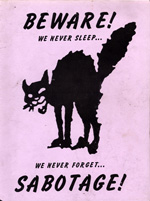
…
-
No Compromise, Periodicals
No Compromise #8 / Strategic Non-Violence for Animal Liberation
10.20.11 | PermalinkNo Compromise #8 / Strategic Non-Violence for Animal Liberation Insert (1997-1998, Minneapolis, MN)
On November 16th 1997, nine years prior to the day that I turned myself in to federal prison in the SHAC 7 case, I was arrested in Anaheim, California. Activists from around the country had descended upon the home of Disneyland to protest the American Association of Laboratory Animal Scientists and we soon found ourselves facing a small army of law enforcement officers. They had miniature tanks, riot suits, pepper spray, batons, counter sniper units on rooftops, and a willingness to use all of the above to maintain the right of vivisectors to keep cutting open living animals. The demonstrations that day set in motion a chain of events that would change the face of grassroots animal rights in America. What does any of this have to do with No Compromise #8 and it’s insert? Allow me to explain.
Freeman Wicklund was a vibrant, young activist from Minnesota. After animal rights militancy had been severely hampered in the late 80’s by grand juries, arrests, and the presence of informants, Freeman was one of the activists who had helped pick up the pieces. His organizing with Student Organization for Animal Rights had made Minneapolis a sort of mecca for direct action oriented vegans, and his projects in the early 90s included traveling to England to bring back literature, documentaries, and interviews about the strengths and weaknesses of the movement abroad. These materials proved to be very influential, and after a short period of contributing to publications such as Out of the Cages, Freeman started No Compromise magazine with a few friends. No Comp, as we called it back then, was the spark that lit a prairie fire. After its publication actions against animal abusers hit a fever pitch.
The 1990s were a complicated time. On the one hand a lot of dedicated, sincere people were taking tremendous risks and making large sacrifices to liberate animals from harm. On the other hand, thrill seekers and status hunters wanted to make a name for themselves while having a little adventure. The epicenter of the latter phenomenon was Salt Lake City. The straight edge scene in Utah was notoriously violent and cultish, and it adherents had attached veganism to their gang-like mentality. Direct actions were on the rise in the area, but many of them were being performed by people who could care less about the politics. When Freeman visited the state in 1997 to help train young people to deal with grand juries, he found a movement based on bragging and scene points. Animals were secondary to climbing the straight edge social ladder, and snitching and self incrimination were epidemic. Disgusted with what he saw there, Freeman began reading the works of pacifist Gene Sharp, and slowly he began to have personal doubts about the role of sabotage and aggressive protest.
Those private conflicts became very public in Anaheim. The AALAS protest drew hundreds of people from multiple states and ended in 8 arrests. While Wicklund was being arrested he began to shout that he was opposed to the ALF at a nearby camera which he mistakenly believed belonged to news media. (The camera was being operated by the police to gather evidence against the protestors.) While we were being detained in the Orange County Jail he told the other arrestees that he was a pacifist now, and upon his release he announced via e-mail lists that he would be quitting his job as editor at No Compromise. When issue #8 was released it contained an editorial announcing his departure, along with a 16 page insert that detailed the focal points of his new strategy.
The supposed “violence vs pacifism” debate is unlikely to ever be resolved, but the contentious battles between the two sides of that argument can sure tear apart a movement. Freeman, for his part, was not content to simply let his views be known. His actions now provide us with a clear road map of what not to do with tactical dogmatism; he began traveling the country denouncing direct action at conferences, he sent out press releases denouncing ALF actions, he even went so far as to visit and disrupt meetings of pro-direct action organizations, including Student Organization for Animal Rights, the group he once worked for.
Many people who had been inspired by Freeman now could not decide where they stood and slowly drifted away. Actions slowed to a standstill as infighting raged and many activists just decided to flee the internal drama. By the start of 1998 the number of grassroots groups were declining and regional networks were falling into disarray.
As time went on Freeman faded into obscurity. His activism became a hodgepodge of confusing moves like running for a school board position in Minnesota, giving equal time to the meat industry when he would table, and requiring that members of his group sign a pledge acknowledging that he was their leader. When his court date in the Anaheim case came around he skipped it to give a lecture about the failings of the Animal Liberation Front. I did show up for my court date, and was sentenced to 45 days in one of the most violent county jails in the United States. There, while on hunger strike, I rejected my own pacifist tendencies, and started down the path that would ultimately lead to my participation in the Stop Huntingdon Animal Cruelty campaign.

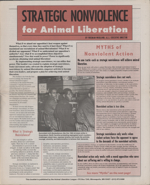
…
» Next Entries
